As I advance into old age I suspect I'll retreat ever deeper into solitude. To this end I will write in my own language, in my own alphabet, and produce photo essays comprehensible to no one but myself.
By Mark Fenton
Published February 01, 2010
I recently came across a scrapbook containing postcards that I kept when I was a small child in Regina.
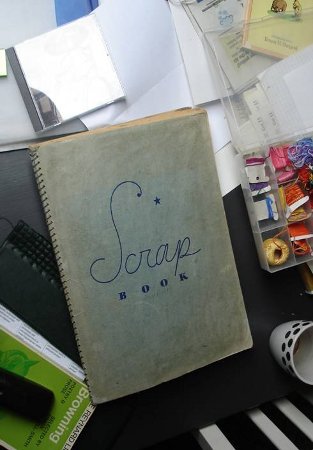
Regina is the capital city of a Canadian province called Saskatchewan, a place most Canadian's would only consider visiting once they've vacationed in Cuba, worked on a farm in a developing African nation, and made a year-long journey through the whole of Southeast Asia.
This is not accusatory. I guarantee you I would never have visited Saskatchewan if I and my family weren't from there.
This is a shame though, because Regina has some unique assets, such as:
Stretches of downtown you can traverse in the middle of a weekday without encountering another person
Excellent places to park next to ferociously straight curbs
A fifth floor view out of the city in all directions from anywhere in the city (from those admittedly rare buildings that have a fifth floor.)
More philosophically, Regina forces upon the visitor urgent and primal considerations about the shape and scale of our planet, and our insignificance in the cosmos (i.e.: Sky is inescapable; even downtown.)
I often feel a connection between Southern Saskatchewan and the stark minimalism of Carl Andre's sculpture.

This essay isn't about Regina, but on a recent visit there I stayed in the Hotel Saskatchewan. Returning to the city where I spent my early childhood helped me understand my predilection for being in open areas where no one else goes. Being in open areas where no one else goes isn't a free choice option in Saskatchewan. There's just no alternative.
As a result, being in open areas where no one else goes is seldom questioned by authorities. Security guards and police officers, or even people who might call security guards and police officers, are too scarce and distant to see me and judge me as creepy and malevolent for being in open areas where no one else goes.

INCIDENT: I wandered casually into the laundry room of the Hotel Saskatchewan and snapped this photo below. I neither attracted suspicion of employees, nor repelled the sensibilities of guests. CONCLUSION: Regina is not a magnetic field.
Note the hairline of sky above horizon and below the midsection of the window frame. (The Hotel Saskatchewan is at centre of downtown and you can see out of the city. See? I don't make this stuff up.) This line is even from one end of the horizontal to the other, and I promise you the effect would be the same regardless of what window you looked out. And then note the sky, even and infinite, in the rectangle above. There is a lack of anything in this room, including dust or sound. Seldom have I captured nothingness as profound as this. I think of these lyrics by Lou Reed:
Candy says,
I hate those quiet places
That give the smallest taste of
What will be.
If these places trouble me less than they trouble Candy, that may be because I have found myself in them since earliest childhood. If Candy's glimpse of the afterlife is accurate, I'm well prepared.
But this essay isn't about Regina. Though the scrapbook was compiled in Regina (perhaps out of a desperation to impress upon my young mind that there were places other than Regina) I was most interested to discover this postcard I received from my Dad when I was still very young, a postcard that take us eastward, to Ontario, and therefore that much closer to what this essay is about.
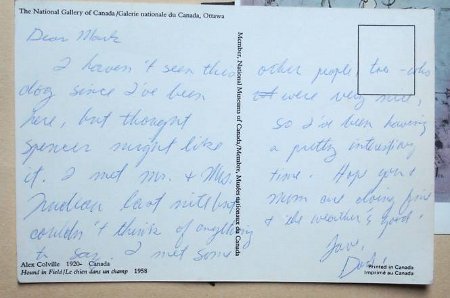
You can tell I'm a young recipient by the way it's written. Dad and I still write to each other but we sometimes use bigger words now. The postcard wasn't mailed or even stamped. I'm guessing he bought it and got busy and ended up writing it on the plane trip back to Regina, probably from Ottawa (see below). I've done stuff like that with my kids.
The detective in me decided to look closely at the content of the card to determine an approximate date. I quickly discovered a sentence with historical information.
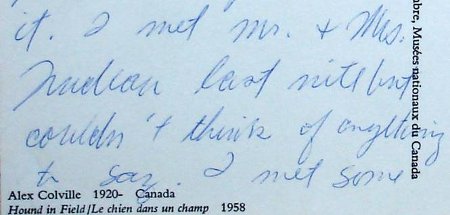
I wouldn't have known what to say either, but then, why on earth would I have become I writer if I could do things like converse ably in a social setting with distinguished people?
Wikipedia tells me that Pierre Trudeau and Margaret Sinclair were married on March 4, 1971 and were legally separated in 1977, so that's the window within which this event took place and was recorded. It would seem that Pierre was uncharacteristically devoid his legendary gift for witty conversation. (It might not have been a good day for the couple, but I'm just guessing here.)
In any case the trio will stand forever frozen in 197-, static and silent like a set of very peculiar action figures. I have no idea what function brought my father and the Prime Minister together. I suppose I could e-mail him (My Dad. Obviously.) and invite him to hit the comments section of this publication if he remembers the event, and feels inclined to share more with us.
I know this essay isn't about Regina, but there's one more point I'd like to cover before slicing into the meat of my subject. At the time of the Trudeau wedding I was a grade one student at Athabasca School. I remember this because as new readers we were encouraged to bring news items into class.
On March 5, 1971 a fellow student named Kent had clipped a report of the wedding out of the paper. I remember Mrs. Lowkin nodding to confirm that this was good information (as though The Leader Post was in the habit of fabricating stories of Prime Ministerial nuptials, and post-publication fact-confirmation was yet another item on the arduous list of a grade one teacher's responsibilities.)
Mrs. Lowkin looked displeased, as though the item was inappropriate for grade one and quickly moved on to a student named Lorraine who had a clipping about a fire in a car that had killed an eight-year-old child. (Mrs. Lowkin was an excellent teacher by the way, but already an advanced age in 1971, and I fear she may have moved on to the quiet places that I've had only the smallest taste of. Requiscat in Pace Mrs. Lowkin.)
When we arrived home that afternoon, there was significant chatter on our street amongst our moms (I know what you're thinking; but on Wascana street in 1971 all the dads were at work until five, and only the single mom in the corner house had a job out of the home, so it could only be our moms) about the 30 year age-span between the newlyweds. (It wasn't the youth of the bride per se that was frowned upon. All our mother's were married at 22. It was the point-spread that was scandalous.) No good would come of it.
One could have forgiven, we overheard, a ten year age difference, or even, at a stretch, a fifteen year age difference, but the age difference between Pierre and his new bride was the kind of thing that eroded the very bedrock of Canadian society, whatever they might consider acceptable in Ottawa. My friend David and I were playing with Lego in the living room and were being glanced at obliquely by the mothers as though to indicate there was a lot more they could say about this shocking state of affairs if there didn't happen to be children present.
But this essay isn't about the snippets of rectitude overheard in the living room of 2904 Wascana Street, Regina, Saskatchewan, S4S 2G8, March 5, 1971 (Google Street View that and track North to Albert Street, East to Queen Street, and North again to Athabasca School if you're unemployed or bedridden and want to make your reading time stretch).
It was only the most idle curiosity that made me turn the card over and read its contents, which are, of course, the business of no one but the sender (if you can call a person who doesn't stamp and post the postcard, but rather just hands it over to the recipient, a "sender") and recipient.
No, it was the Alex Colville reproduction on the front of the postcard that appealed to me.
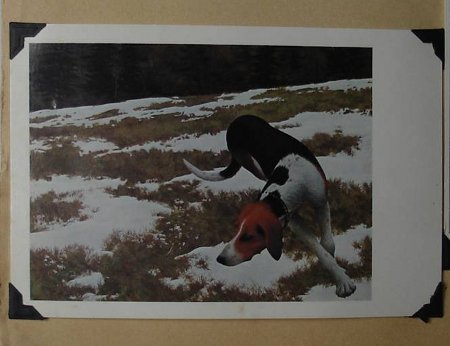
(It's about here that the essay becomes clearly not about Regina but about Hamilton, which is of course why it appears in Raise the Hammer and not in whatever the Regina equivalent might be.)
I was struck that our family dog (the one we have now, not Spencer, the family dog who gets namechecked in my Dad's card) formed shapes similar to the Colville beagle as she frolicked in the snow. I thought the thin layer of snow that had recently accumulated would form a similar backdrop, and I resolved to recreate the image myself.
The family dog is a rescue dog and like many such she is damaged and complex. The dossier on our dog states that she has a gentle caring disposition within the home but is outdoors, unfortunately, a killer of small animals, which is unsurprising in a hunting breed like the Catahula Leopard Dog she probably is. (I am not joking. Google it.)
The farm family that tried to adopt her before us was lulled into a false trust by her docility in the home. ("She was so affectionate indoors, we...we don't know what happened!") They let her out to roam on her own, where she slaughtered a coop's worth of chickens and ducks at a neighbouring farm.
She was sent back to the rescue agency and held in the canine equivalent of cellblock eight awaiting judgement. After due consideration, probably consisting of an interview by a panel, she was reprieved and ultimately paroled to our urban residence.
We are cautious with her. Whenever we go somewhere where she could meet other dogs we dress her in a safety muzzle.
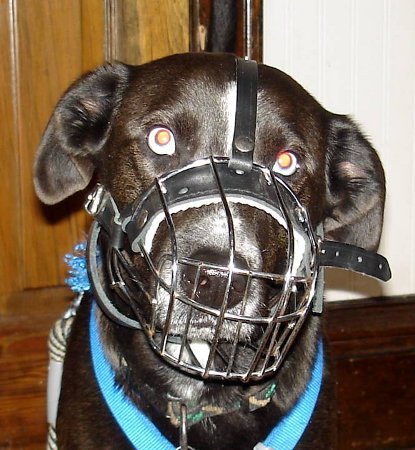
similar to that used to transport Hannibal Lecter from prison to prison
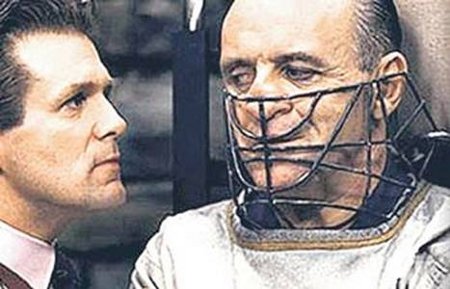
I realize I've proved myself to be the kind of hypocritical liberal who comes out against the right to bear arms in an urban setting, but feels righteous adopting a deadly weapon in the form of a rescue dog. The kind of weapon-owner who's not even that rigorous about keeping the safety-catch on. Judge me as you see fit.
So. To re-enact the Colville moment I and the family dog (hereinafter referred to simply as S— to preserve her anonymity) walked out to Kay Drage Park.
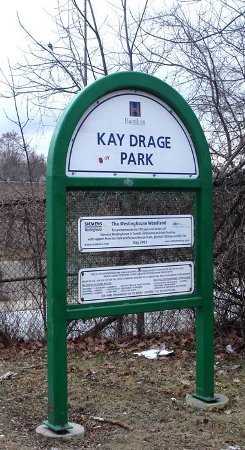
I wasn't able to find a lot about Kay Drage Park online. If anyone has information on the eponymous Kay Drage please post it in the comments section. And Kay, if you're reading, I hereby request forgiveness in advance.
When I first heard Kay Drage Park spoken, I thought people were saying Gatorade park, which made no sense other than maybe the odd colour the water takes on in spring. I then got the spelling more or less down, and decided that drages must be a geological formation unique to Hamilton. (If there is no such term, I forward a motion to name any shallow water passage bedded in concrete and skirting a disused landfill site a "drage.")
I imagined that Hamilton's drages were organized alphabetically west to east, and this one
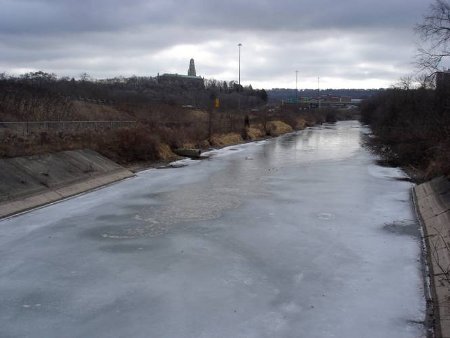
was the one between J Drage and L Drage. Hamilton is the waterfall capital of North American, and surely they must all level out into streams and these streams would likely be alphabetized and referred to as "drages." Sounds like a mixture of dredge and drag. Like the kind of water body you'd section off behind yellow tape to preserve the integrity of the crime scene. People in uniform feeling slowly along the drage-bed with boats and poles.
The drage also evokes for me Robert Browning's "Childe Roland to the Dark Tower Came." If you don't believe me, stand and meditate on the drage at dusk and see how it mirrors thoughts of the lone Knight on his quest.
A sudden little river crossed my path
As unexpected as a serpent comes.
{...}
Which, while I forded-good saints, how I feared
To set my foot upon a dead man's cheek,
Each step, or feel the spear I thrust to seek
For hollows, tangled in his hair or beard
-It may have been a water rat I speared,
But, ugh! it sounded like a baby's shriek.
I will not be fording K. Drage. Thank heavens for the bridge. In my more serene moments, I like standing above the drage and admiring how a number of transportation modes exists in parallel.
For those in a hurry, east and slightly above my head is the 403. People racing to and from work if things go well, or stopping and starting in gridlock if they don't. A journey that has nothing to recommend it other than being the fastest way to get somewhere important. Time the traveller never gets back, as its loss does nothing to enhance or lengthen our lives.
To the east of the Park itself are the tracks. Sadly, in this country often said to have been been built on a railroad, this has become a slow, pricey and moribund means of passenger transport. Having done it seldom I have a romanticized image of people who take trains. I imagine myself in the dining car sitting with a person possessed of an unusual accent and a faraway gaze. A kind of person I wouldn't meet anywhere but in a dining car of a train.
A journal in a language I can't identify is folded on the white linen tablecloth next to the silverware. We drink cocktails and have a conversation I will never forget. We each have a destination but the destination is not the point, because life is, after all, the journey.
To the west is Macklin Street. Cars, bikes, pedestrians and their dogs, foxes, rabbits, and deer, travel the road or the space around it in about equal proportions, having carved out something of a tolerant if not friendly equilibrium. There's neither threat nor stimulation to Maklin Street. There are no sidewalks and just enough traffic, as well as rare dogs and squirrels that I need to keep S— from savaging, that I have to keep my mind on what is around me.
And there is neither information nor beauty enough to ignite buried memories. As such this walk may be the closest I ever get to a low stress intentness on the things before me right now. What Buddhists and Taoists call "no mind". A state, I imagine, that my father experienced on meeting the Trudeaus.
I would like to add aviation to my list of transportation options. All I can think of is the possibility of using the park itself for an emergency landing. I haven't measured but I think there's just enough runway before you hit the soccer goals. I hope it never happens, but it's probably comforting for pilots to know it's there.
And then of course directly below us is the drage itself, which would be pleasant way of travelling north to Coots in a Kayak. South I'm guessing it turns into a waterfall or a dead end or something.
But let's backtrack for a moment on the entrance to Kay Drage.
Here's the view of the entrance that you'd use as the photo shot for calendar of Hamilton parks. I urge you to line it up symmetrically next time you're there.
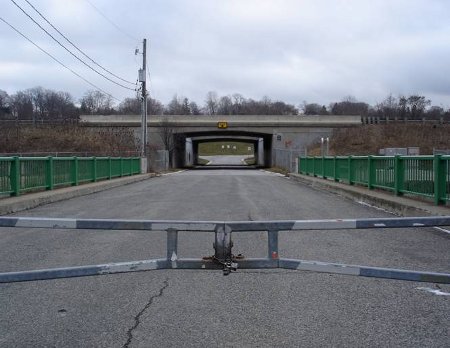
I made an immediate connection with the low lying concrete symmetry of Louis Khan's seminal Trenton Bath House.
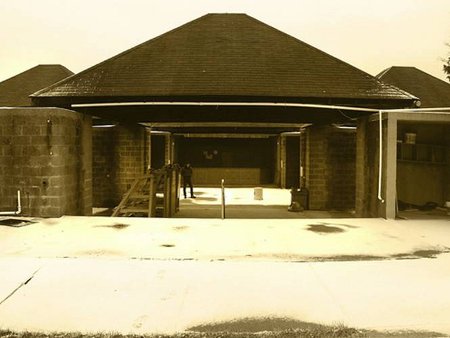
And walking onward
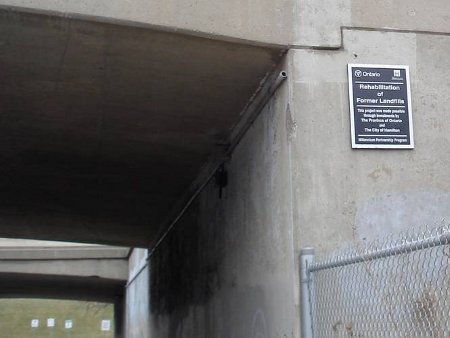
and under the 403, I stood here looking at the view which is being promoted on panoramio.com

with the text "this photo is selected for Google Earth?" cryptically below it.
I did a bit more internet research and discovered The City of Hamilton parks page promotes Kay Drage as follows:
"Kay Drage Park is a large sports park with soccer and baseball fields that was built on top of a former landfill site," a description that isn't what I'd call a hard sell. Scroll up to the description of Harvey Park on the same page, which by comparison is downright ecstatic. It is a nice park for walking or picnicking and provides an excellent view of the harbour. The site also has considerable historical significance.
Well la-di-da. I guess those of us who live by Kay Drage had better not expect a guided history tour with complementary snacks or anything.
I tried to shoot the underbelly of the 403 from the same angle as that on panoramio.com. I was curious to see how frequently the graffiti changed.
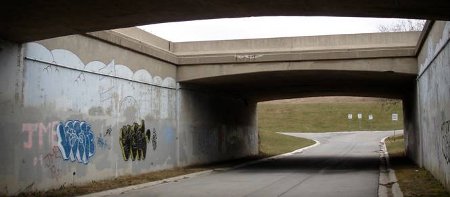
Not much. I noted that the graffiti manages to be simultaneously homophobic and ejaculatory (I've censored the former). If City of Hamilton wonders why Hamiltonian families don't flock to Kay Drage of a summer weekend for picnics, a photo of the approach might be something for them to zapruder.
But as I'm about to succumb to outright despair, I come upon what appears to be an unironic moment of sweetness,
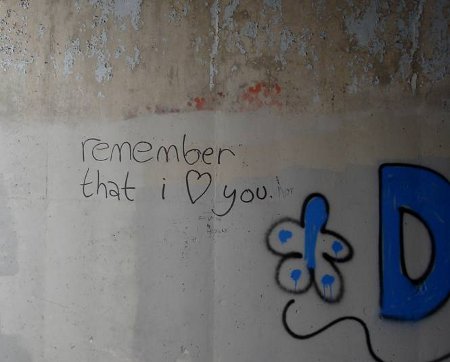
which impresses me not as a message from the author to a lover who might pass this on the morning walk to work or school, but rather as a global message from a higher power to all of us.
These moments are fleeting in Kay Drage, but more powerful for being so. Immediately I think of an uncharacteristic ray of hope in Malcolm Lowry's Under the Volcano. Geoffrey Firmin, the protagonist, has died, and M. Laruelle, his friend discover's a letter Geoffrey wrote in Mexico to his (Geoffrey's) estranged wife in California. The letter was never mailed. M. Laruelle opens and reads it.
...[R]ight through hell there is a path...and though I may not take it, sometimes lately in dreams I have been able to see it ... I seem to see now, between mescals, this path, and beyond it strange vistas, like visions of a new life together we might somewhere lead. I seem to see us living in some Northern country, of mountains and hills and blue water; our house is built on an inlet and one evening we are standing happy in one another, on the balcony of this house, looking over the water.
M. Laruelle is a distant witness to Geoffrey's drunken, unmailed cry of hope for his marriage, now by his death made irreconcilable, just as I'm a distant observer of the Trudeau marriage from an unmailed postcard, and have information about the marriage that the Trudeau's themselves didn't have at that time. The letter, as ephemeral and lost in the noise of the world as a Kay Drage graffiti tag, is a heartfelt cry of "remember that I love you."
Moving onward and upward (literally) the traveller comes upon the awesome grass expanse that is Kay Drage Park. A place as evocative as anywhere in Hamilton of "those quiet places that give the smallest taste of what will be..." Or, if you prefer, evocative of another passage from Childe Roland.

...no sooner was I fairly found
Pledge to the plain, after a pace or two
Than pausing to throw backward a last view
To the safe road, 'twas gone! grey plain all round!
Nothing but plain to the horizon's bound.
I might go on; nought else remained to do.
That's at least how I felt on my first visit to the park. I'd come upon it accidentally, and didn't know it even was a park. I suspected I'd wandered onto the site of a nuclear testing ground from the cold war era. The kind of place a country collectively feigns amnesia about. (Where better for such a site?) That day, the park was under a layer fog which blurred the horizon in every direction, and it was at this moment I made the connection to Browning's knight who doubts he will ever be delivered from the Gothic landscape of the subconscious. Soccer goals loomed before me

sprouting from the plain like "The Lightening Field," a late 70s art earthwork by Walter de Maria
which marries the earth to the sky by means of 400 lightening rods.
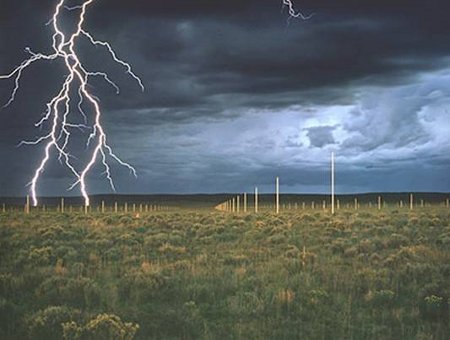
And when I saw the goals through the fog, there was no way I could imagine people playing soccer in this godforsaken place. I thought only of The Lightening Field's mission to assist nature in its capacity to channel forces we can only tremble at in helpless terror. I glanced over my shoulder at the silhouette of Christ the King cathedral, and Browning's poem spoke to me yet again.
What in the midst lay but the Tower itself?
The round squat turret, blind as the fool's heart
Built of brown stone, without a counterpart.
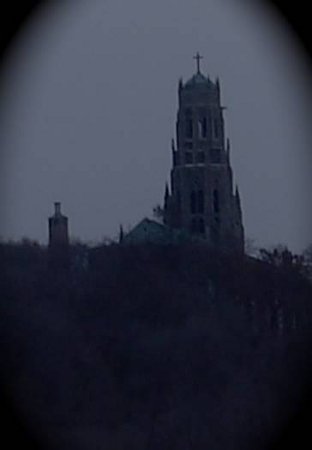
But that was a long time ago. This essay isn't about the Robert Browning inspired terror of my first brush with Kay Drage Park. This essay is about trying to get a photograph of S— in fresh snow to create an homage to Colville's "Hound in Snow."
Posing a dog is harder than one might think. I developed a new respect for William Wegmans' little films of Weimeraners assembling themselves backwards
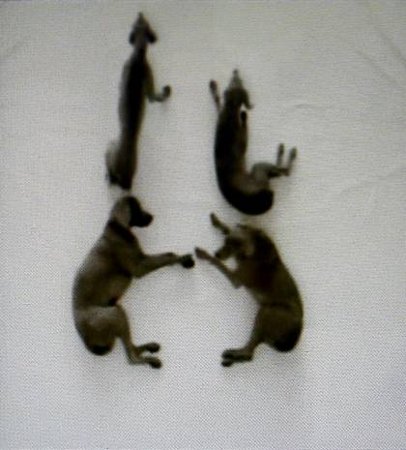
in order to form letters of the alphabet.
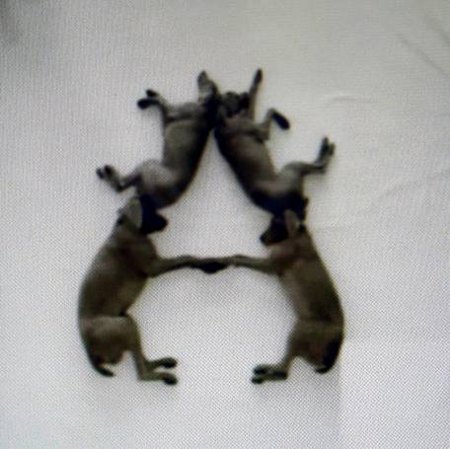
Having enjoyed these films on Sesame Street I'm disappointed never to have found Wegman Bold in any of any word processing programs I've worked with. Not so much for body text, which might be hard on the eyes after a while, but rather for titles and ad slogans.
I wasn't trying to make S— form anything as finicky as a letter. I had hoped she'd whip herself into a coil of explosive energy like Colville's hound. But instead she sat and adopted a thoughtful hunter stance, probably imagining things she might kill.
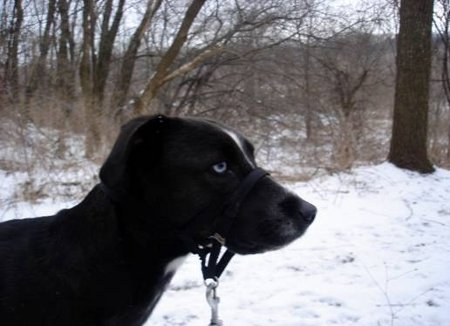
In the far distance I could see skaters on the water at Coots, and I felt like S— and I should be meeting up with the party in Breugal's "Hunter's in the Snow."
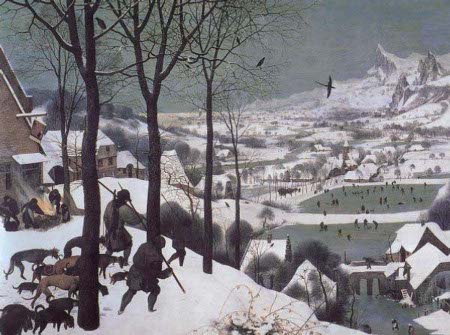
I went off leash with S— at this point, which I realize I probably shouldn't have. There was no one else in Kay Drage and I was close to her the full time and could see hundreds of metres in every direction for someone coming. Though if you wanted to push me on this you could say I'm like a rifle enthusiast who thinks it's OK to fire off his gun because he's in an empty field and there doesn't seem to be anyone as far as he can see.
Again, I have no rebuttal to your just condemnation, except to say that shooting scenes in urban space without permissions while creating potentially dangerous situations is the sort of thing that indie filmmakers boast about in the special features segments. I'm just saying.
In a children's story called "How the Alphabet was Made," Rudyard Kipling creates a myth of how the Roman alphabet came to be, based the organic animal forms such as tusks, bones, sea shells etc. He even supplies a graphic representation of how these forms became the simplified into our letters,
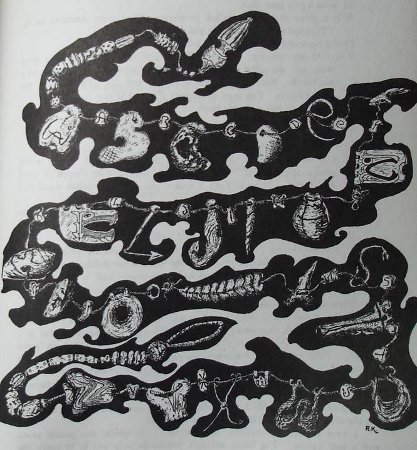
as well as an explanation of the source of each letter.
A is scratched on a tooth-an elk-tusk I think.
B is the Sacred Beaver of Tegumai on a bit of old glory
C is a pearly oyster-shell-inside front.
and so on through to Z.
I had, by this time abandoned all hope of posing S— into any position whatsoever. But the idea of a new alphabet had taken hold of me.
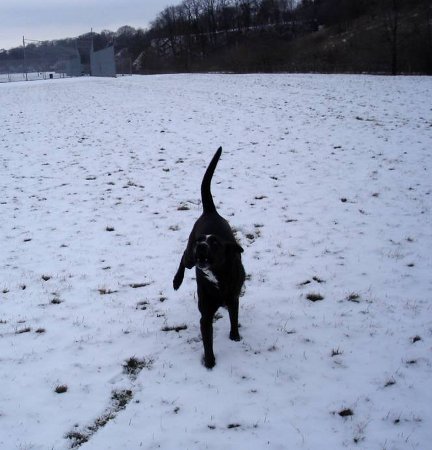
Rather than urging animals into the shapes of an already established alphabet, as Wegman does, I would let the random forms of S— create an alphabet of its own.
After all, animal forms are everywhere in Egyptian hieroglyphics, even as they refined their characters into a phonetic alphabet.

In constructing a new language I would record the myriad sounds the dog produces at the moment I snap the photo (S— is nothing if not an expressively and sonically diverse howler) to supply vocal correlatives for the shapes.
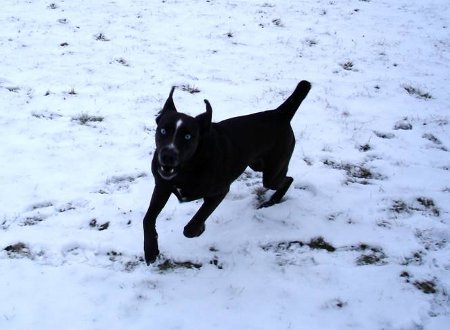
As I advance into old age I suspect I'll retreat ever deeper into solitude. That's what you'd guess of a person who already revels in "the quiet places that give the smallest taste of what will be." To this end I will cease writing in English. I will write in my own language, in my own alphabet, and produce photo essays comprehensible to no one but myself.
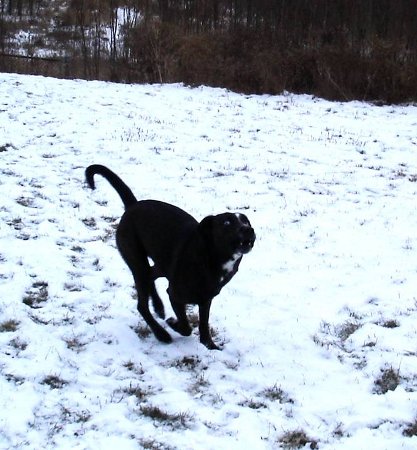
These essays will return ever more frequently to memories of earliest childhood, memories of days in Regina. Maybe again to a postcard from my father,
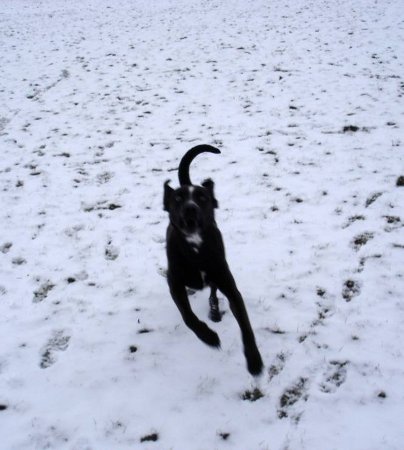
which records meeting a national leader and his wife, figures year by year becoming less the stuff of political scrutiny and more the stuff of legend.
By xyz (anonymous) | Posted February 02, 2010 at 13:19:35
http://epe.lac-bac.gc.ca/100/205/301/ic/cdc/hamilton/index.html
KAY DRAGE PARK
Location: along the Chedoke Expressway north of King St. W. and west of Dundurn - Ward 1
Survey Descriptions: 80 Macklin St. N.: Plan 115; Registered Plan 62R6018, Parts 1 to 4; 74 Macklin St. N.: Plan 115, part of Lot 321 to part of Lot 328
Size: 12.74 hectares (31.48 acres)
Official Naming Date: November 24, 1981; also November 24, 1987
Features: soccer fields, ball fields, benches, walkways, parking
History
The park site was once a swamp and then was used as a dump from the mid 1950's until 1974. This land was originally known as the West Hamilton Landfill site.
In September of 1981 the sports field was completed. Later that year Kay Drage Park was named in memory of Kay Drage (1925 - 1978), a former city alderman who died from cancer. Kay Drage was well respected and known for her dedication to her work. She was devoted to improving and maintaining the City's parks. She was well-known for getting the landfill site converted into a park. The site was officially named again on November 24, 1987.
There was much talk about Kay Drage Park being environmentally unsafe, however, all testing has concluded that any chemical concentrations found have been well below the Ministry of Environment guidelines.
Mark, thanks for making me late for work...(your virtuosity with the written word was engrossing) :)
By 9th Floor (anonymous) | Posted February 05, 2010 at 10:14:58
I look over Kay Drage from my apartment building, and while I always thought it was an odd place for a park, it does seem to be a popular spot for early morning and weekend dog walkers. In fact that seems to be its primary use - I have yet to see anyone use the sports fields, but maybe that will change in the summer. Better a park than a landfill, in any event. Nice piece Mark.
By Lurkalicious (anonymous) | Posted February 05, 2010 at 10:35:40
I've loved RTH ever since I first discovered it...... but there's an extra-special place in my Hammer Heart for Mark's wonderful, magical essays. Thank you so much for sharing.
By andy (anonymous) | Posted February 06, 2010 at 11:08:49
Mark, even as you produce these incomprehensible photo essays, keep posting them here. Loved it.
By kevin (registered) | Posted February 08, 2010 at 18:27:35
Awesome, as always. We have a catahoula rescue dog as well: issues. Perhaps you can translate your "new language" pieces into English so we can continue to enjoy your great photo-essays.
Comment edited by kevin on 2010-02-08 17:28:12
By Historian (anonymous) | Posted February 12, 2010 at 03:15:22
Kay Drage was a humanitarian and always ready to fight for the underdog (no pun intended) and by her efforts was the person responsible for the first C-scanner to Hamilton General Hospita.
Her husband Paul was also a well known activist.
By kay drage - versailles (anonymous) | Posted April 20, 2010 at 13:01:15
http://www.masters-of-photography.com/K/koudelka/koudelka_hound_full.html
By Dan (anonymous) | Posted June 17, 2010 at 01:27:02
Could this be a possible spot for the Pan American stadium? Who cares if it's a former landfill?
By Alora Dannon (anonymous) | Posted April 21, 2012 at 13:57:02
I also love Kay Drage...so does my handsome pooch. Best secret dog place in the hammer. I think it's fairly unchecked for off-leash rebels because it's off the main roads and *most* people are respectful. I always pick up after my pooch!! We also stay off the diamonds and walk clear of areas that are obviously being re-seeded. Thanks for the acreage "xyz". I always wondered...now I know 31 acres is the perfect number for my dream property in Northern Ontario.
By iamcanadianeh (anonymous) | Posted June 25, 2013 at 18:47:23
I hope you have a leash on your dog when I come to Kay Drage for a walk with my dogs. My dogs and I have been attacked countless times by owners that refuse to leash their dogs in a public park. I have a disability, my dogs are big and I would not look forward to being caught up in a confrontation with any dogs ever again.
Dog owners should have care and control of their animals twenty four seven and adhere to park rules that state dogs should be on a leash
I have mine on a leash, please remember some disabled people do own dogs too. have a great day!
You must be logged in to comment.
There are no upcoming events right now.
Why not post one?